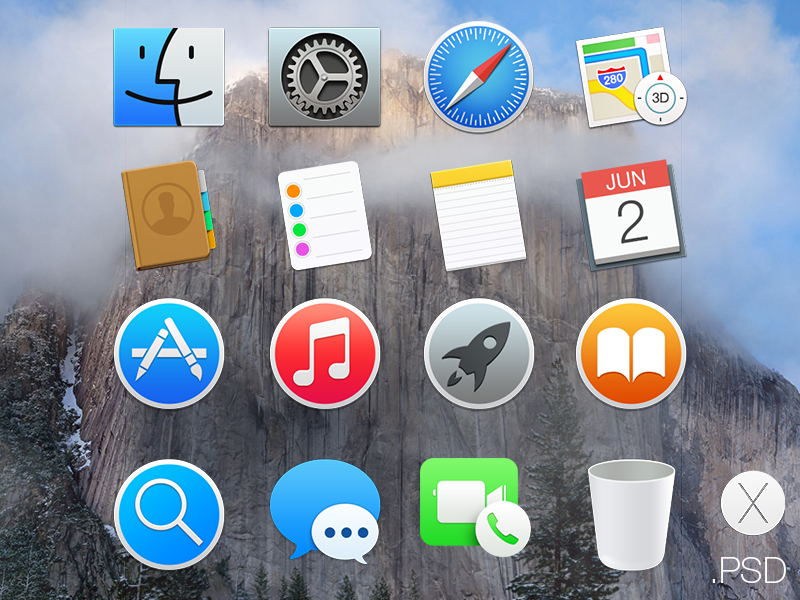
- OS X LITEICON ICON SETS MAC OS
- OS X LITEICON ICON SETS UPDATE
- OS X LITEICON ICON SETS DOWNLOAD
- OS X LITEICON ICON SETS FREE
Click and drag the custom icon in the lower half of the window (where we are keeping all of our icons) up onto the application that you want it to replace. For this example, lets work with Applications.Ĥ. The top right of the window, under where it says "Change," gives you four options: System, Applications, Dock, and Volume. Make sure that you have selected whatever types of icons you want to customize.
If you want to add more later, you can do that.ģ. Drag all the icon files that you want to use. A New Collection is now created and visible in the left pane. Click the + button in the lower left corner of the window.
OS X LITEICON ICON SETS UPDATE
This way when apps update and you lose your changes, you can just open up your iContainer and apply the changes rather than having to go through every app and manually fix everything. In order to save time in the future, you'll want to create your own, custom iContainers.

They will appear at the bottom of the window, and you can drag the individual custom icons up onto the stock icons which you'll find at the top of the window.
OS X LITEICON ICON SETS DOWNLOAD
Download some icon files, then in Candybar, select File > Import > Icons. If you would prefer to only use some of the icons in an iContainer (or any icons you find that don't come in iContainers in the first place), the process is similar to Lite Icon. Select "Use These Icons" and Candybar automatically applies them to all the assigned applications, folders, and other system icons. Any image that is in the proper format (which you'll find has an extension of ".icns") can be placed on top of a stock icon. Lite Icon simply requires you to drag your desired icon onto the icon you want to change and hit apply. When you launch Lite Icon, you'll be presented with a window that shows your system icons, (things like hard drives, folders, etc.).
OS X LITEICON ICON SETS FREE
We'll begin with a free option, called Lite Icon. So let's now look at two applications that will help speed up this process. Secondly, every time an app updates, your icon will return to its original form. First, if you plan on customizing much of your system, this can take a long time. This is a simple method for manually changing an icon, but there are a couple of problems with it. Your Calculator icon is now changed! This works for most applications and system icons like folders, but not App Store icons, which I'll discuss later. Scroll down and find Calculator.Īfter selecting the stock icon, paste your new icon over it and the window will show the change. Open Finder, select Applications from your right pane. Open the downloaded folder, and you'll see a calculator replacement icon. Go to The Icon Factory and download the icon set for Mac, (the middle button).ġ. I am a big fan of a graphic designer named David Lanham, and I am going to change the stock icon for the Calculator to one which he designed.
OS X LITEICON ICON SETS MAC OS
For the purposes of this demonstration, we are going to change Mac OS X's calculator icon. Whatever your reasons for wanting to change things up, I'm going to show you a couple methods for changing an icon. Or maybe having owned an iPhone or iPad has gotten you accustomed to the uniform theme of the rounded square icon, and you wish you could duplicate that experience on your Mac. You may want to change these because you don't like the way the icon looks. You can change any of these, as well as the icons of many applications you've downloaded. When you first started up your brand new Mac, there were a bunch of programs that Apple gave you with the operating system. Visual interfaces that we've come to know and love over the past couple of decades use icons as a quicker method of opening something on your computer, rather than forcing you to type out a command. Just about anything on your computer, be it an individual file, an internal drive, an application, etc., has an icon associated with it. Nothing too exciting, right? Well let's talk about an area where you have much more power. Set this to any of the presets or create your own. Next in General settings, you get a few more options to choose from for the color of highlighted text. The top example here shows the Blue setting, and the bottom shows the Graphite. Changing the "Appearance" color affects things like buttons in system messages.


 0 kommentar(er)
0 kommentar(er)
